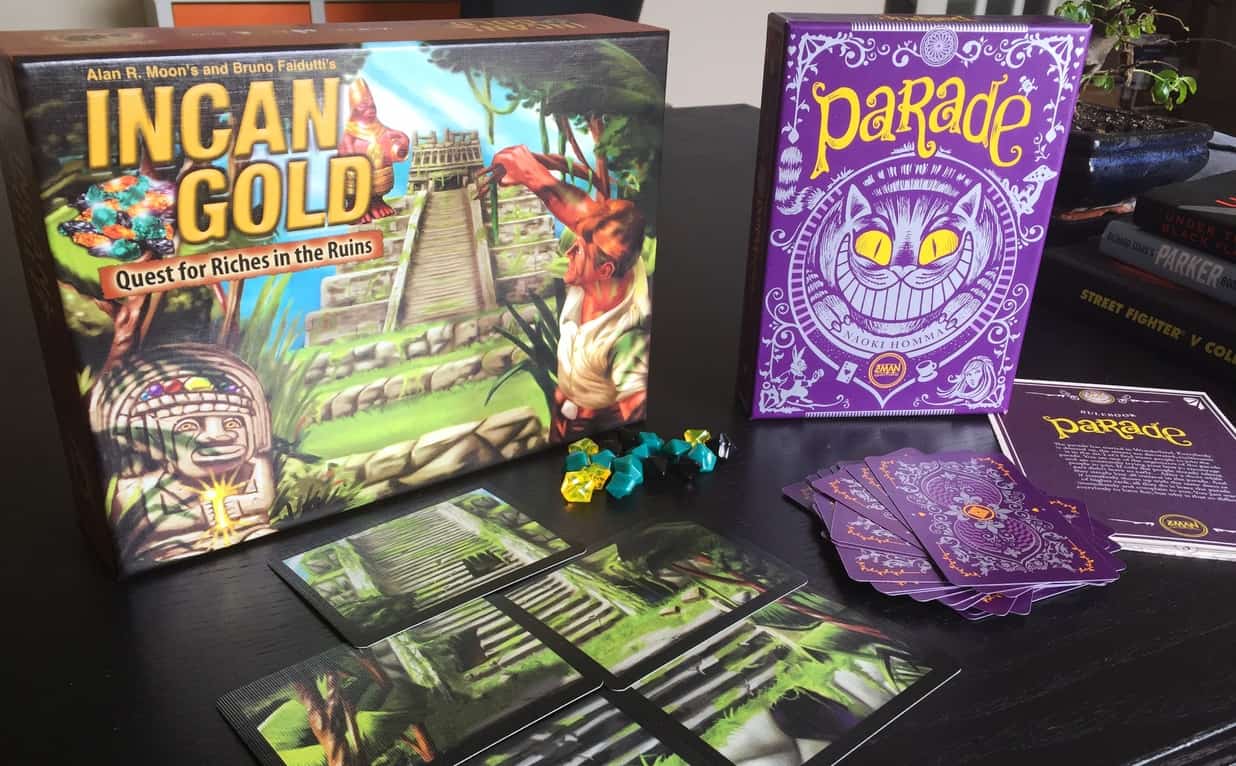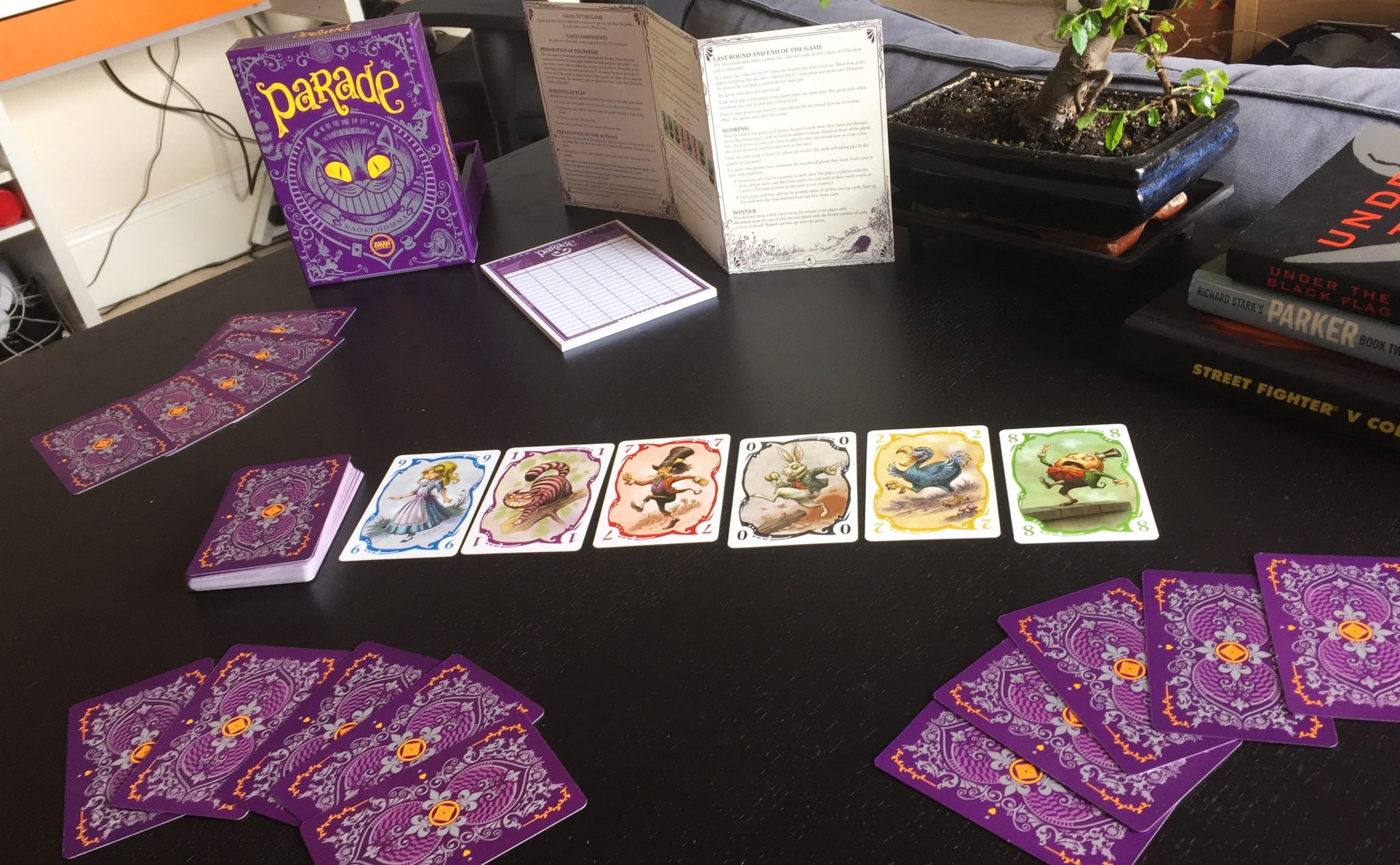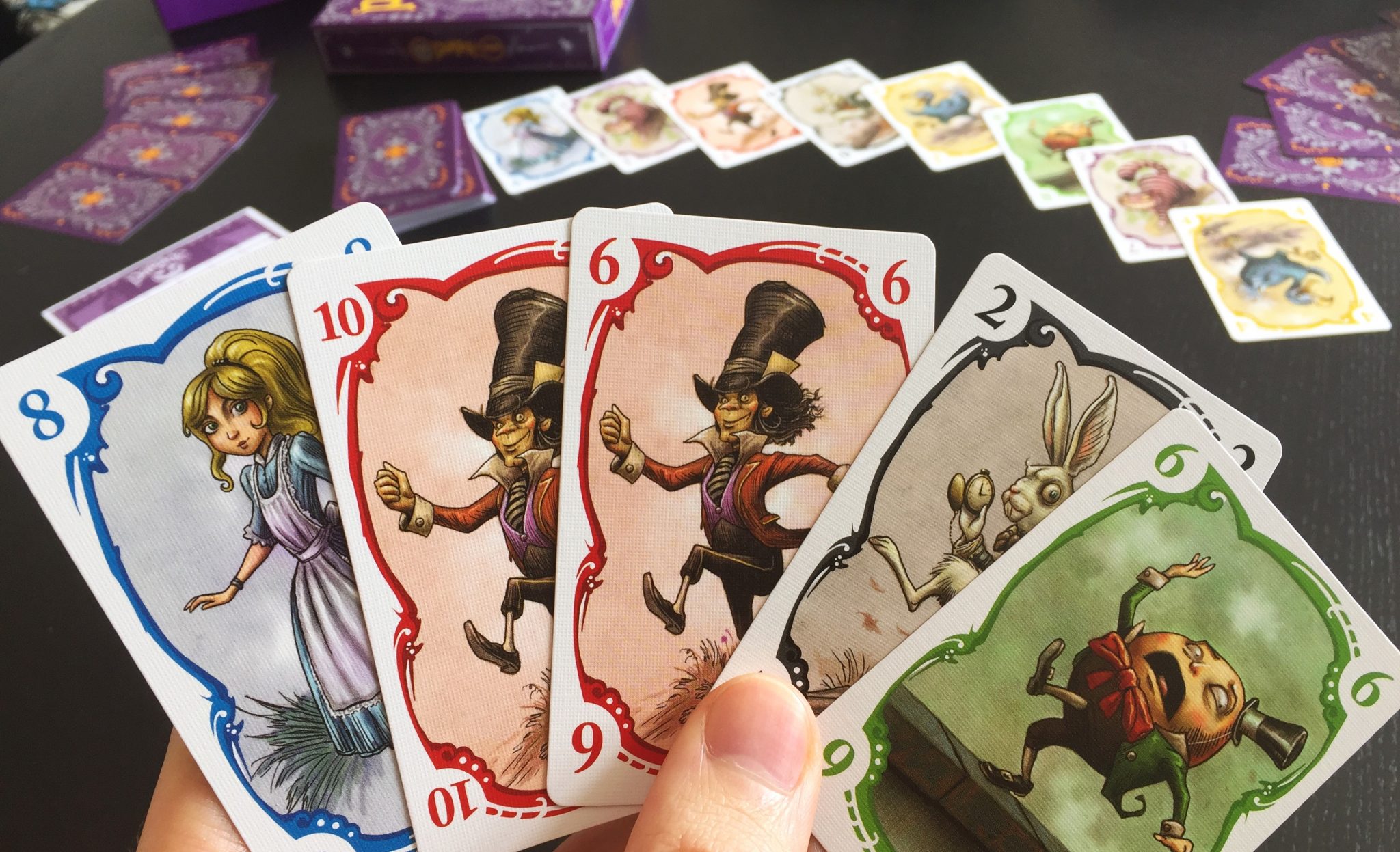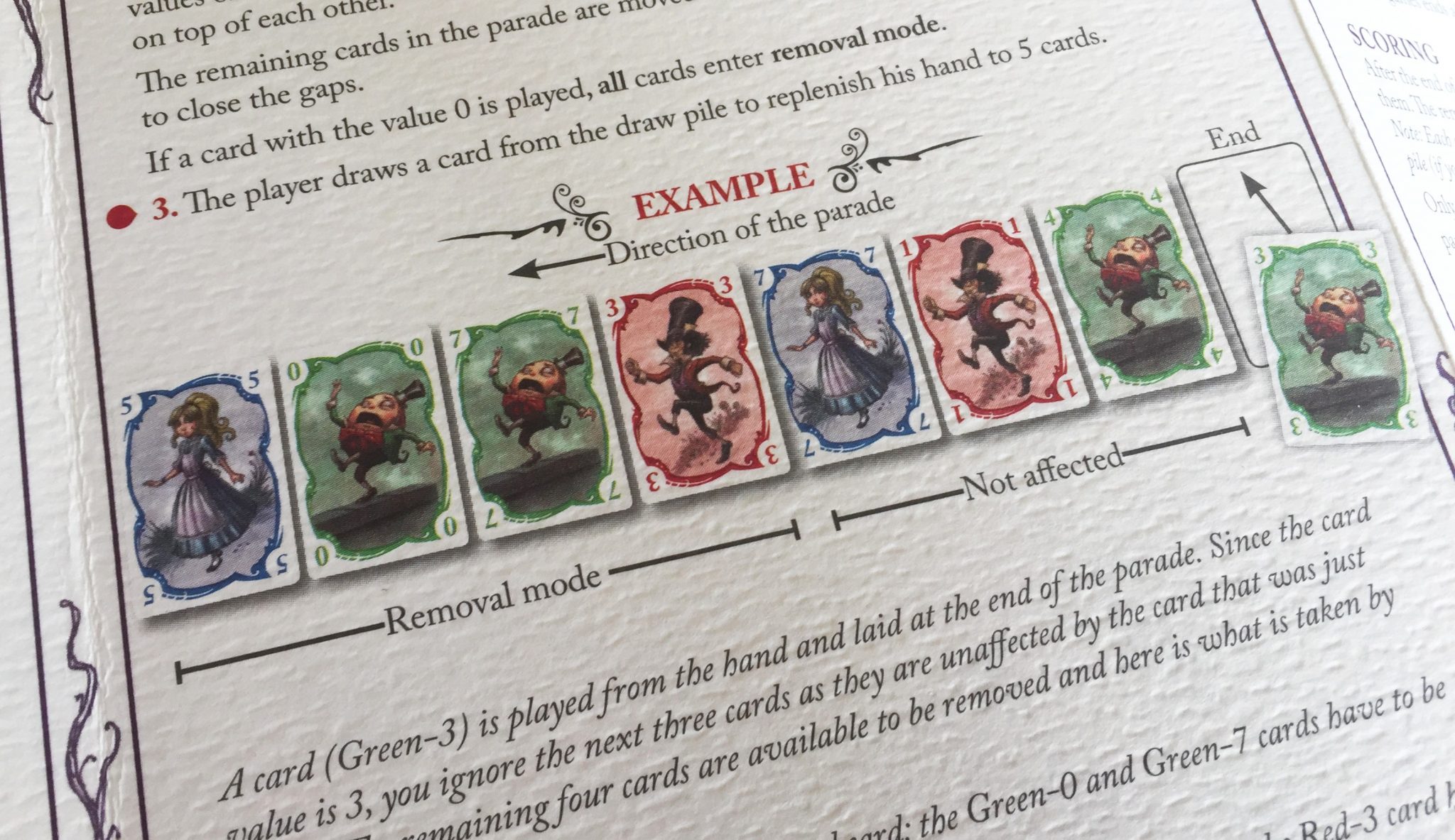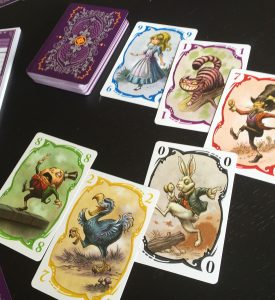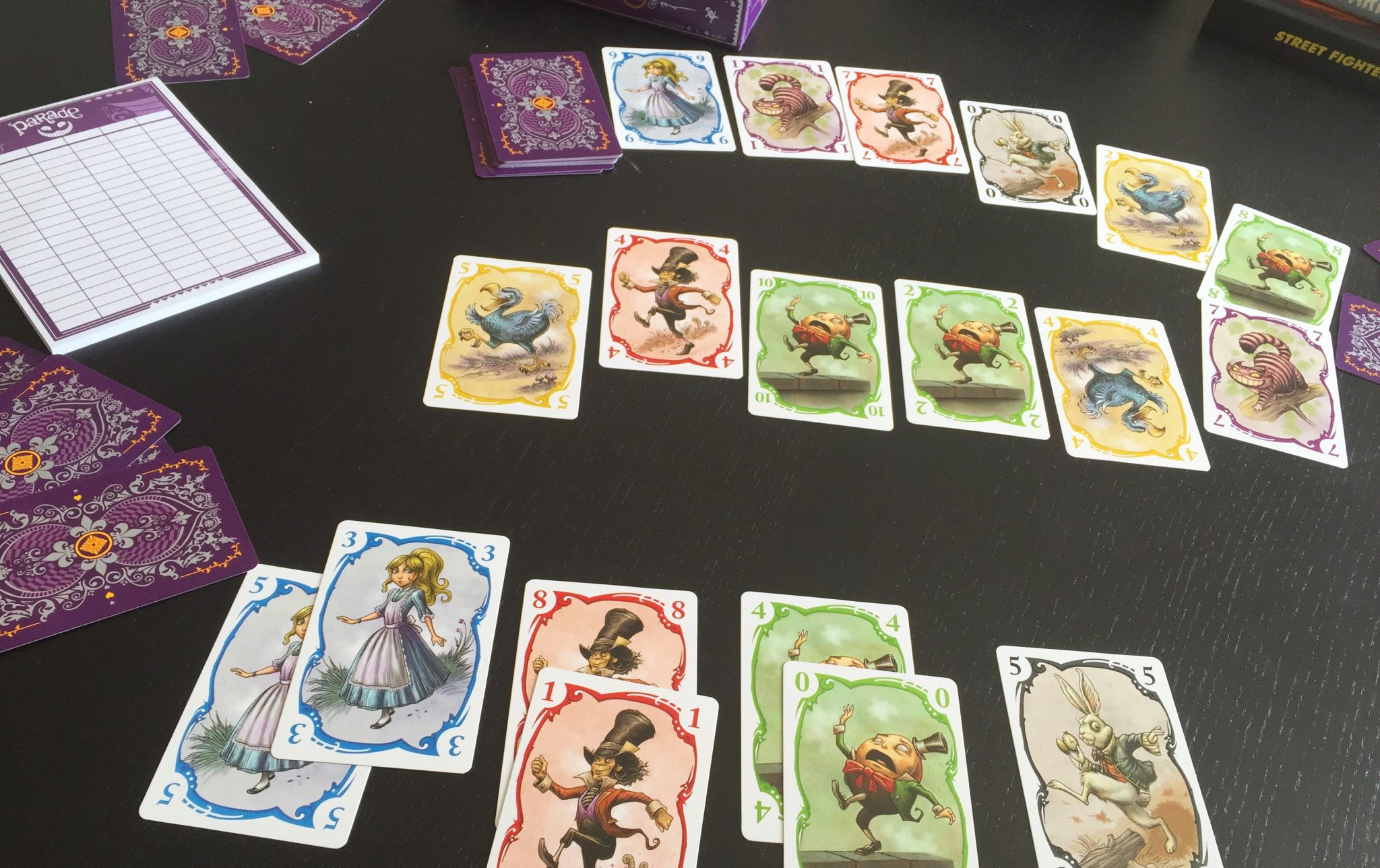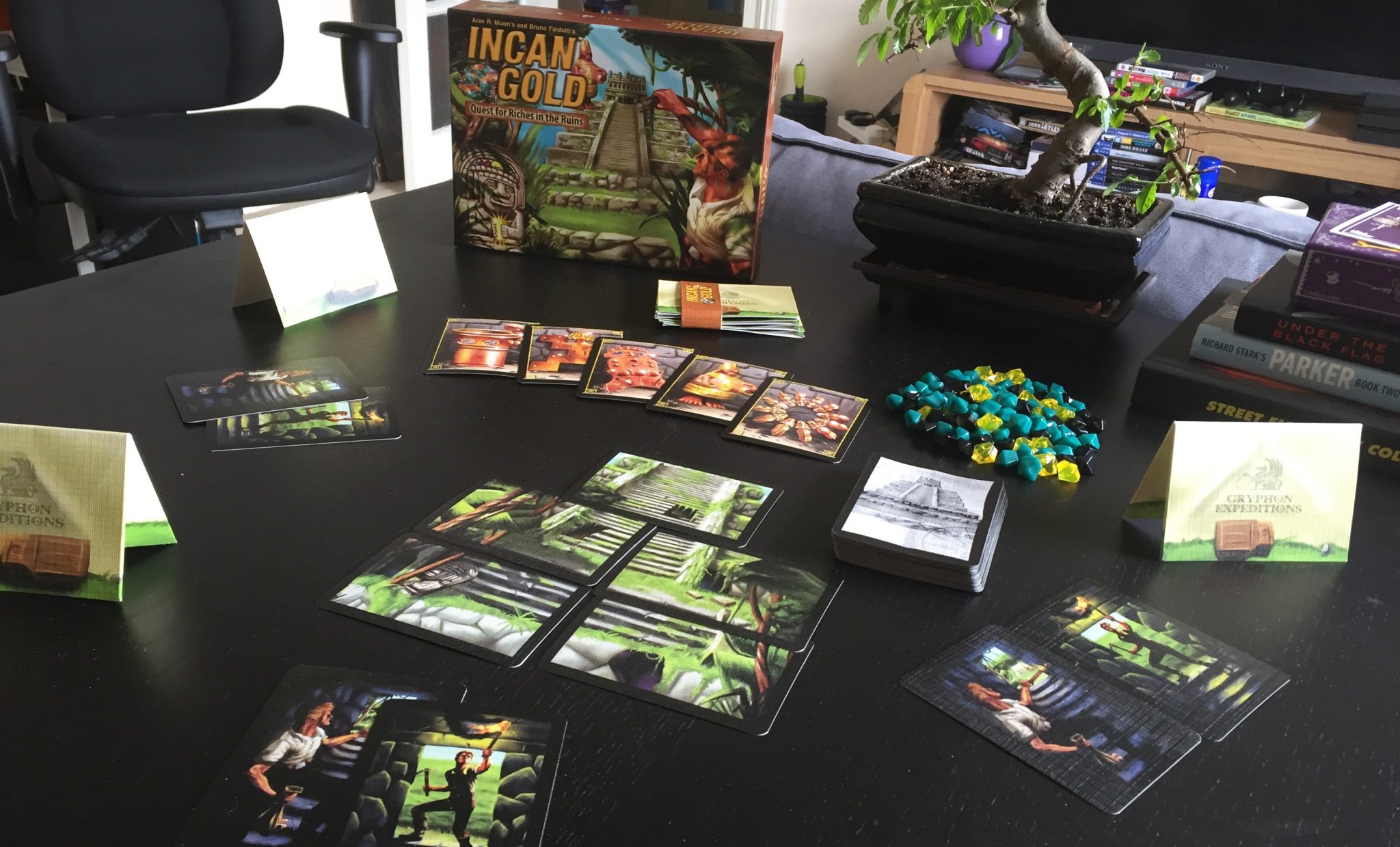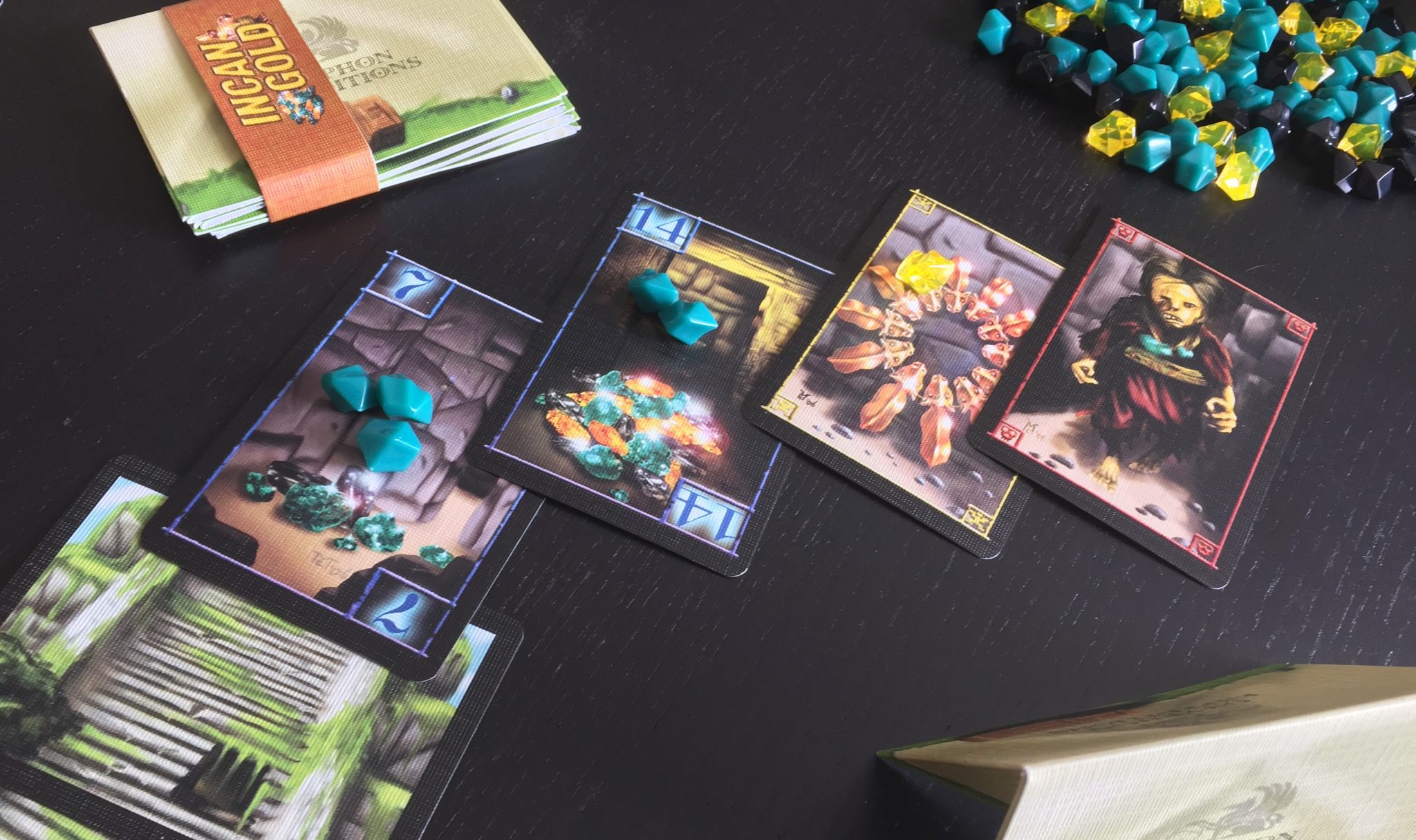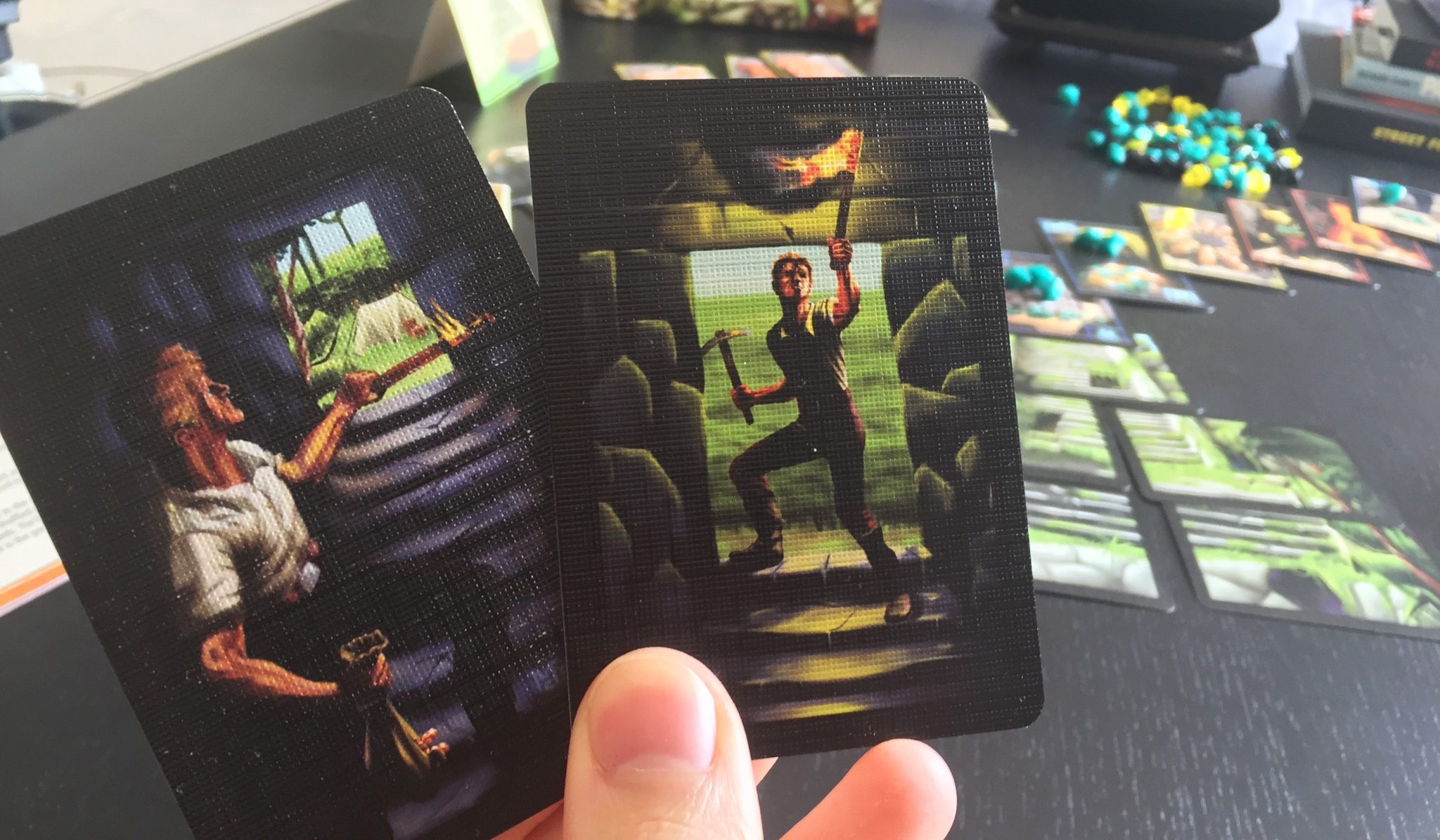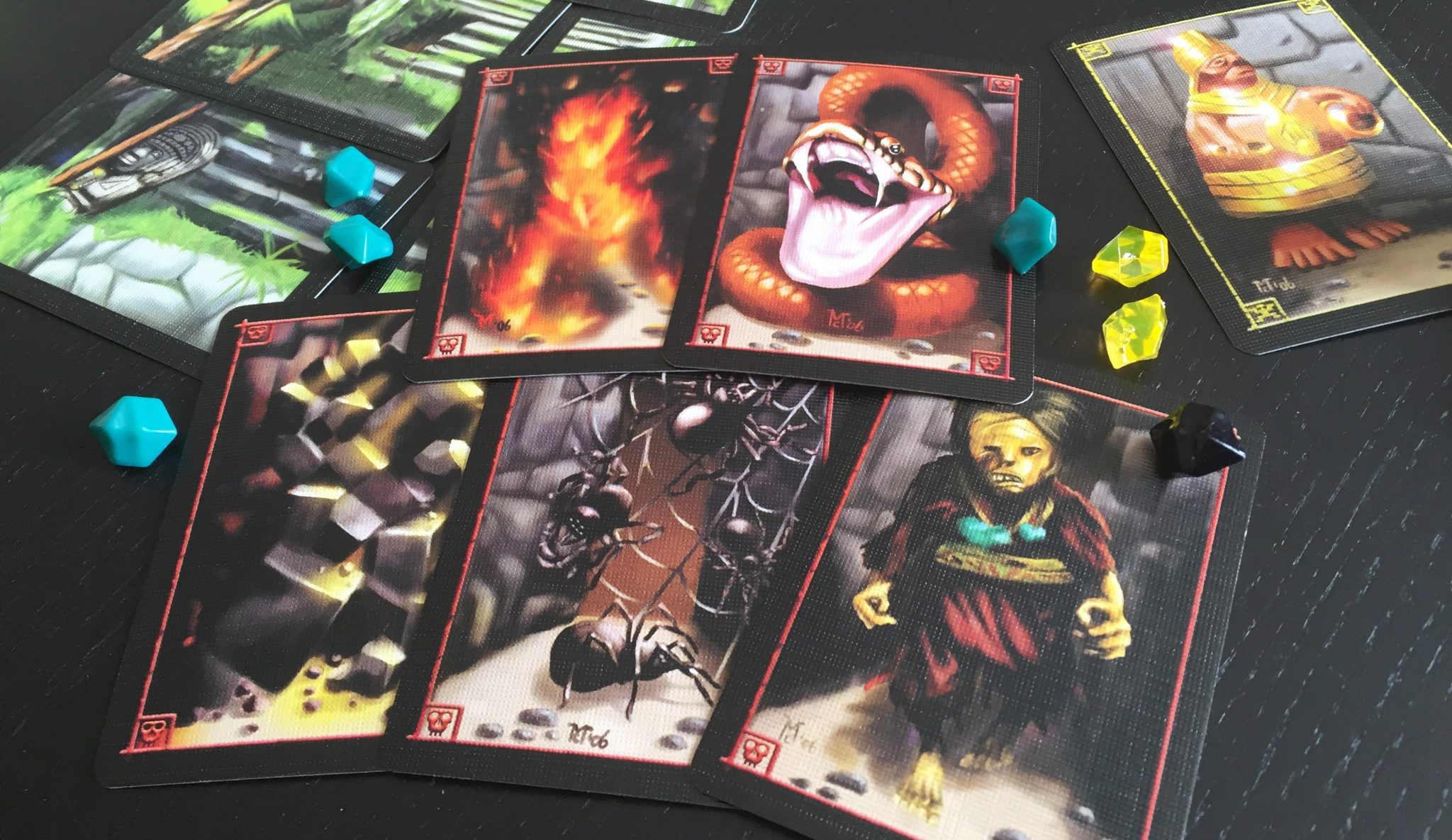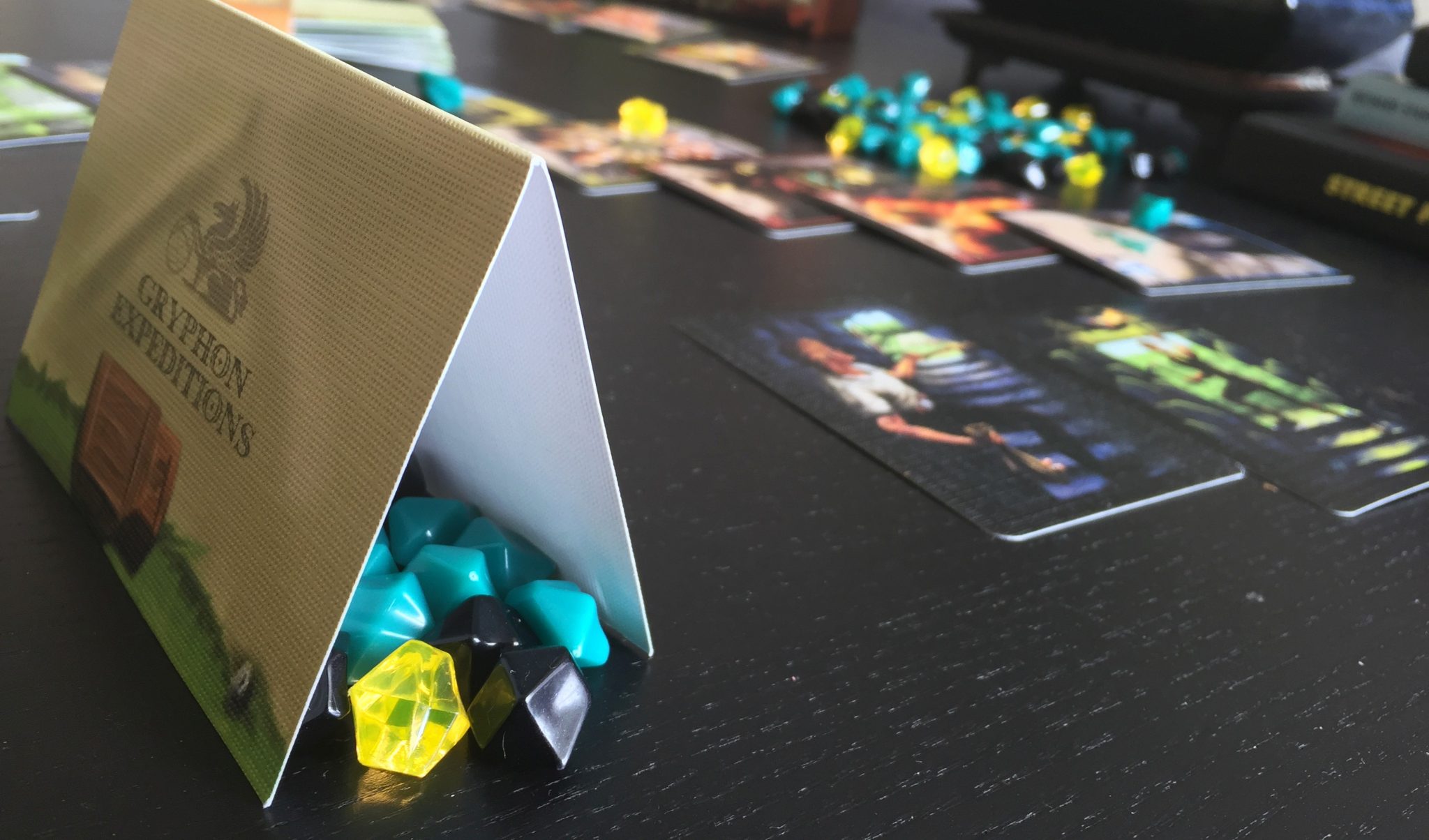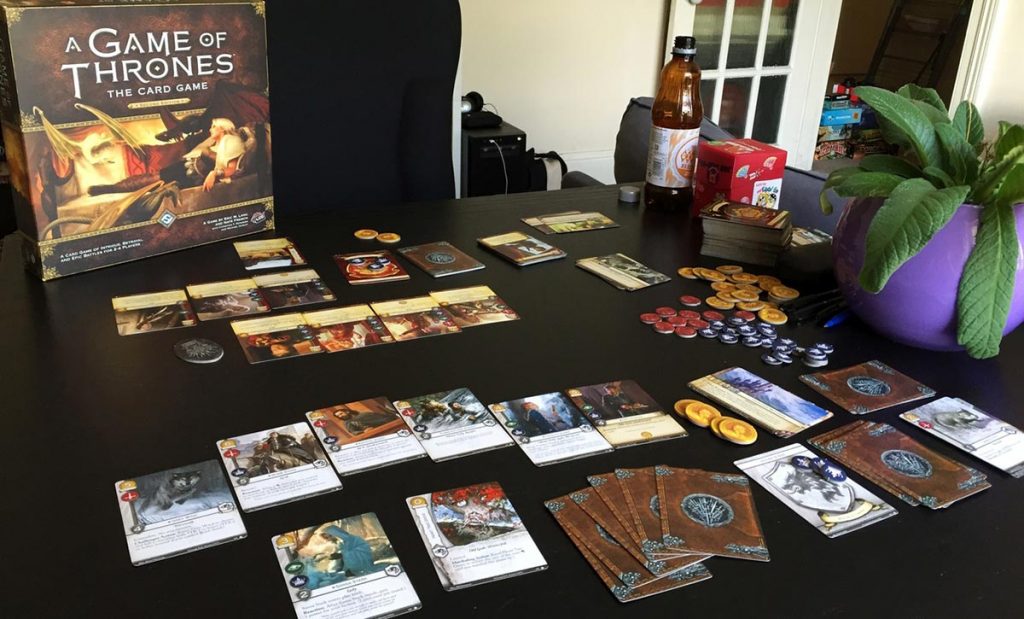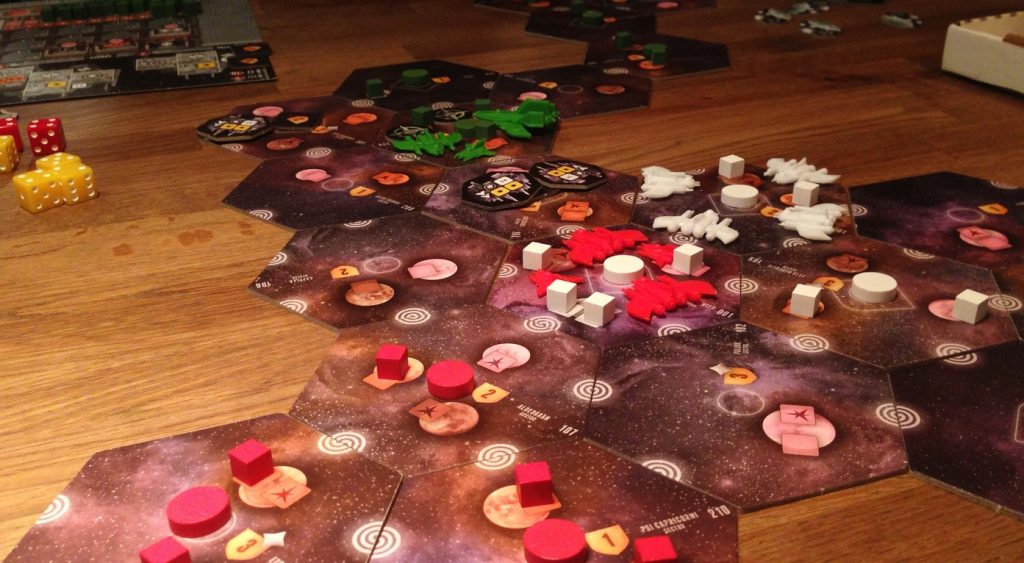Quinns: You know double-yolk eggs? Those rarest of treasures that whisper “It’s all going to be ok” up from the pan? Well, today you get a double-review! Enclosed within the brittle shell of this article are not one, but TWO of the greatest card games we’ve ever played, full of fatty fun and caloric goodness.
Please ensure your credit card is secured in your official SU&SD fast-draw holster before continuing. We’re serious. These games are very, very good.
We begin with a return to Z-Man’s beautimus line of “deluxe card games”. Did you buy Arboretum after our review? Did you follow it up with Archaeology when we reviewed that a few weeks later? If so, the following might be hard for you. You’re going to want Parade not just because it’s fantastic, but because it represents the opportunity to have a cute lil’ trio of these small boxes on your shelf. I’m no accountant, but that’s an investment that simply makes sense.
Parade has the least rules of the three, but that’s not to say it’s the simplest. We’re on a trip to Wonderland, where all is not as it seems. The good news is, there’s a silly parade! The bad news is, there’s a very real chance you’ll ruin it for EVERYBODY.
Here’s how it works: Parade begins with each player being dealt a hand of 5 cards. 6 more cards are then dealt face-up in the middle of the table in a long line, representing a happy parade of wacky characters. What fun! On your turn you simply add a card from your hand onto the end of the parade, and then draw a new card from the deck.
The problem is, the inhabitants of Wonderland are easily distracted and liable to wander off. This next bit’s a little tricky. Bear with me.
When you add a card to the end of the parade, you check the number on the card you played and count that many cards off from the end of the parade. Any further cards enter the ominously drearily-named REMOVAL MODE. Oh dear, that doesn’t sound like much fun at all, does it Mr. Rabbit?
Any cards in REMOVAL MODE of the same colour as the card you played are REMOVED. Any cards with a number LESS THAN or EQUAL to the number you played are ALSO REMOVED. Oh dear oh dear!
Cards you removed go in front of you, the game ends when one player has all six colours in front of them, your score is the total of all those nasty little printed numbers you’ve collected, and the player with the lowest score wins…
…But we have just two rules left, and you must imagine both of them best delivered through a wild cheshire grin.
The player with the most cards of a given colour doesn’t score any cards of that colour. In other words, being king of the Mad Hatters makes you immune from them, instead of having them savage your score like a pack of hyenas. When the game ends, each player must also secretly select two cards from their hand to join the cards in front of them… potentially giving them the most of a given colour. Or not, if their rival did exactly the same, at which point all they did was upend a plate of extra points down their own shirt.
Your first 15 minutes of Parade won’t be unpleasant – you’re playing cards with friends, lovely cards with lovely purple backs, no less – but once you start realising how the game works… the pace reminds me of a different children’s story. The horrible f***ing boat ride from the 1971 film adaptation of Charlie and the Chocolate Factory.
Initially, everything is calm. Too calm. You’re tossing cards into the parade, collecting meaningless “1s” and “0s” or playing such big numbers than nothing goes into removal mode. And that’s fine! The game lets you do that. But nothing you can do will stop this game from picking up speed as the parade grows longer, and longer, and LONGER, until someone HAS to pick up an ungodly quantity of Dodos.
But wait. That’s… fine! They have so many Dodos they’ll never score Dodos. At which point players have two options. They can either cling to the guard rails as the game goes increasingly mad, trying to collect nothing, or they can steer in to the loss. And two players fighting for one colour is hilarious for the entire table, because when two players start competing for the same colour it’s a sure thing that one of them is just going to outright lose the entire game.
From here, it’s possible to start having realisation upon realisation as the madness takes hold. The more players that are actively corralling colours out of the parade, the easier a time you’ll have collecting nothing. When you’re safe from a colour, you can start willfully pouring that colour into the parade to screw everyone else up, though being too greedy could strip you of your position. That said, you can also goad players into fights you know they’ll lose, because you’re already holding two cards of that colour for the end game. And – oh my god – it’s also possible to deliberately collect six colours if you know you’re winning!
But when Parade does end, I love that it always does it with a final mind-game. If I have 3 Humpty-Dumpties in front of me and you have 2, will you risk playing a third card to bring yourself into relative safety? Because if I choose to play a fourth I’ll have made a dumpty out of you.
I love it. I love it! It’s easy, it’s simple, it’s silly, it’s rich. If Arboretum is the best strategic game in the trilogy and Archaeology is the trashiest, Parade easily earns its own adjective as the breeziest. Play some cards! Make some mistakes. It’s all over in 20 minutes anyway.
It’s just a shame that, after Arboretum and then Archaeology, this game couldn’t have had a six syllable name beginning with “A”. If you’re listening, Z-Man, we’d suggest the following: Accountability, Abominableness, Agoraphobia.
OK. Let’s talk about this bona fide classic for the first time on SU&SD.
Let’s talk about a collaboration between the designers of Ticket to Ride and Citadels.
Let’s talk about a game that plays comfortably with anywhere from 3 to 8 players.
Let’s talk about one of the funniest games ever made.
Do I have your attention? Let’s talk about Incan Gold.
Like Archaeology, players in Incan Gold are explorers (read: crooks) plumbing the depths of an ancient temple. Some of you are going to become fabulously wealthy! Some of you are going to go home with pocket change. And most of you are going to be annoyed.
Here’s how this one works: Each player receives a tiny pop-up tent and two cards that indicate whether you’re going deeper, or leaving the temple. Think of them like a green light and a red light. You’re going to explore five wings of this temple, meaning you’re going to play five rounds, and after that’s done the thief with the most tiny plastic gobbets of gold and turquoise crammed into their tent is the winner.
A round begins with the table’s players all setting off together down a corridor of cards, which are slowly dealt off the top of Incan Gold’s deck. Exactly half of this deck is treasure cards. When one of these comes up you divide its numerical wealth between all the players still pushing down the corridor and, like the professional archaeologists you are, you leave the remainder dumped on the floor.
Players then all select one of their two cards, and simultaneously flash whether they’re going deeper, meaning they stick around to enjoy discoveries further down the corridor, or whether they’re calling it quits, and going home to bank all their accumulated treasure in their tent.
Why would you leave? Well, there are two reasons. The first is that when players leave, they divide everything out one more time as the group sprints back to the entrance again. What happens if you’re the only person who leaves after a given card? Well! Like any professional archaeologist would, you divide it all between one person. Meaning you get absolutely all of it.
The other reason you might leave relates to the other half of Incan Gold’s deck. 15 hazard cards, made up of 3 copies of 5 different hazards: rockfalls, spiders, snakes, pillars of fire and creepy mummies. The first time one of these hazards comes up, nothing happens. You caught a glimpse of a spider, but it’s ok. Who’s afraid of spiders? Not you! When a duplicate of any one hazard shows up, though, the entire remaining expedition panics, drops ALL the treasure they were carrying and charges out of the front door, and get absolutely nothing that round. If you’re like me, you’ll revel in imagining four or five archaeologists all dropping their spectacles, flinging spiders out of their perfectly coiffed hair and squealing in terror as they do so.
And just to make sure each round features adequate levels of hubris and banditry, each wing of the temple introduces a new Incan Relic card into the deck. When you find this object, only one person can get it. Ever. There’s no dividing that thing by two, or three, and certainly not eight. And because the last two relics are worth double, there’s a neat catchup mechanic where anyone can squeak out a win in the final rounds if they can find the bloody things. We’re done here, people! The game’s perfect. Get it to the printers.
There’s so much to praise that I don’t know where to start. There’s the fact that this is a game that stays quick and accessible with huge tables of players, or that stowing plastic jewels in your tent is a marvellously tactile reward. I could point out that this is a card game that tells such an evocative story, despite you being able to teach it in 30 seconds.
Instead, what I want to focus on is how much room this game has for your friends. It’s a good game of balancing risk and reward, and the probabilities are fun, but to really turn a profit you have to predict your friends. And best of all, of the two decisions anyone can make, both of them are always funny to the whole table. Did one person go home? That’s funny. Did EVERYONE go home? That’s funny. Did half of you go home, leading to those players all groaning as they all only get a small cut of the loot on the way home? That’s funny too!
And then you’ve got the beautiful tension from players who choose to go deeper, because the only people more invested than the remaining explorers are the friends praying for them to fail.
And of course, the rewards for venturing deeper get crazier the more people leave, until there’s only one player left and the rewards just explode. You get to keep everything you find. All of it! So why not go a little deeper? Then… maybe one card deeper? Then maybe just one more card after that. And then you go bust, of course you do, and the table laughs at you losing thirty seven separate treasures.
The manual might not be the best, and I’d love to see an edition that prints the “Torch” and “Tent” cards with greater clarity (which is to say, any clarity at all), but these are tiny blemishes on this game’s beautiful, golden Incan face. In a year when a lot of people are talking about the excellent Deep Sea Adventure, I can safely tell you that Incan Gold is better. It’s a celebration of idiocy, and one of the best dumb games (or dumbest best games?) I’ve ever owned.
Shame about the box art. But after noticing it looks like an advert for crap coffee, at least Matt had some fun with it.

